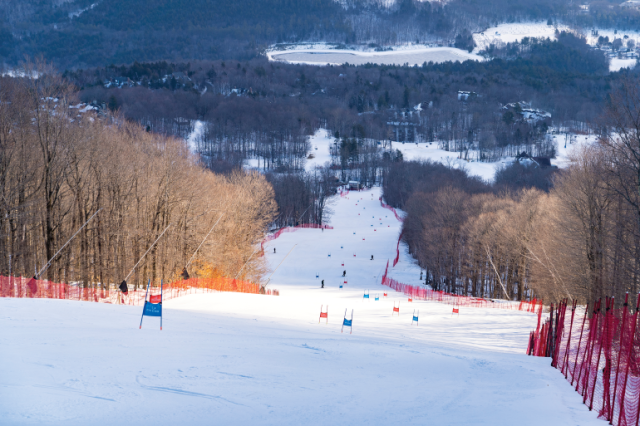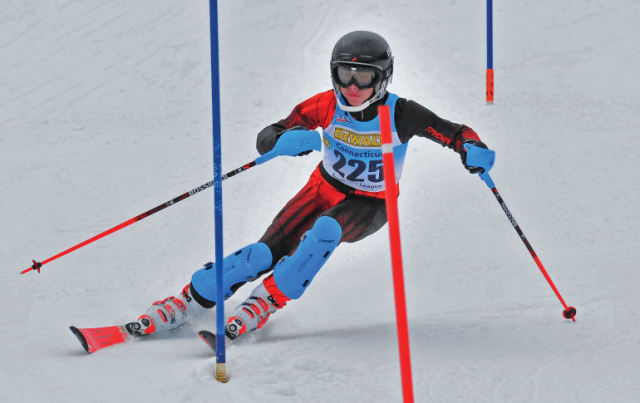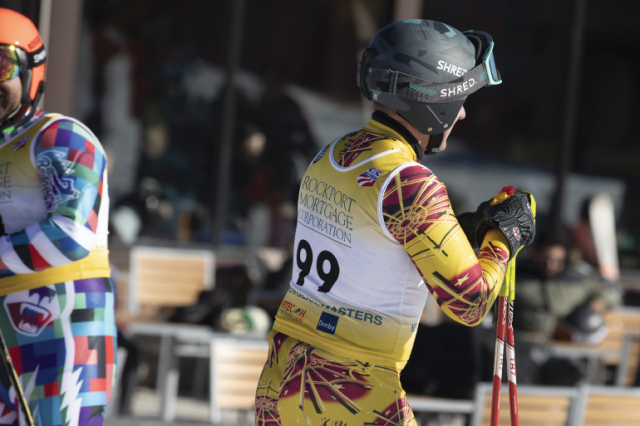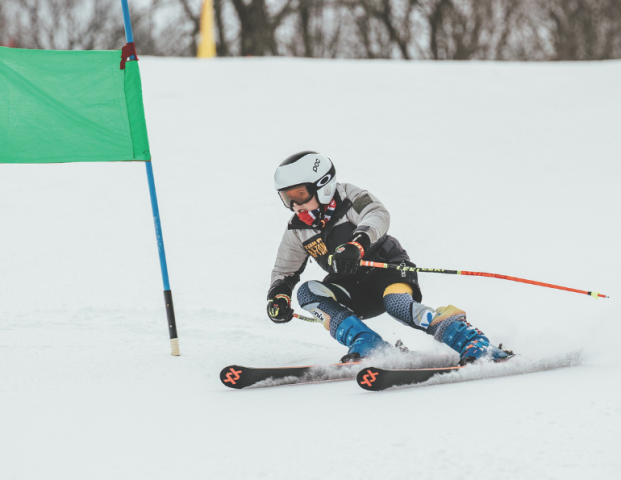Great ski racing careers typically begin at the pipsqueak stage. A pre-school kid takes an interest in speed and competition and enters the local race program, fueling dreams, perhaps, of Olympic or World Cup glory. Even if those dreams prove quickly to be chimerical, the child is gaining something valuable—an enduring love of the sport and an appreciation for the technical precision required to make fast, efficient turns.
In other words, local racing programs aren’t just breeding grounds for future all-stars; they are incubators for the development of future, life-long skiers. If for no other reason, hosting race programs makes good sense.
But hosting a race program isn’t just about nurturing the overall well-being of the sport; a ski area stands to gain materially as well. A well-run program can produce a substantial shot in the arm financially. One general manager interviewed by SAM said that racing and race training generate more than 20 percent of the area’s overall revenue.
Here, we’ll look at some of the logistical considerations that any well-run program must manage.
Variations on a Theme
There are essentially three variations of race programs: those run in-house, manned by resort staff and coaches; programs run by local clubs, ski academies, and/or other organizations, which pay fees to resorts for use of the hill; and programs that are hybrids, merging the two. The choice is determined by a variety of factors, including ski-area size, budget, available staff, and legacy, given that many race programs have existed under the auspices of local clubs for years, often as ski-area ownership has changed hands numerous times.
Regardless of how a race program is structured and managed, challenges do arise. Many are related to integrating a race program with—or segregating a race program from—the activities of the general skiing public. Racing and race training can obviously put stress on managing skier traffic safely on the hill, but they can also cause base-lodge congestion and parking problems. When clubs or other organizations are involved, there is the challenge of figuring out a fair way to divvy up costs and revenues as well as logistical responsibilities.
Still, resort operators say that the benefits of hosting a race program far outweigh the negatives. They have arrived at that consensus, however, often by learning the hard way in developing strategies to mitigate potential problems—by doing things wrong as a prelude to figuring out how to do things right.
 Okemo, Vt., commits one of its 121 trails to race training, which limits disruption for other guests.
Okemo, Vt., commits one of its 121 trails to race training, which limits disruption for other guests.
Big Program, Little Hill
The race program at Mount Southington Ski Area in central Connecticut is a prominent example of a program run the in-house way. “Racing has always been an important part of our business model,” says Mount Southington general manager Jay Dougherty.
The area has more than 100 kids in its regular race program and another 60 to 100 kids in an intro-to-racing program, says Dougherty. But the numbers swell when the mountain hosts races, often on busy weekends. Connecticut Ski League races bring in “hundreds of racers,” says Dougherty, and the number of competitors in Connecticut high school races typically ranges between 400 and 500.
Within a couple of hours of several major metropolitan areas, Mount Southington sees a lot of overall skier traffic on a small layout—just 14 trails on 51 skiable acres and 425 vertical feet. Racing and race training must squeeze into the picture in a way that avoids bogging down the heavy flow of traffic both on and off the hill.
Mount Southington is fortunate that its layout enables a lift and a trail on one side of the mountain to be dedicated almost exclusively to racing. But because races bring in not only racers but also spectators and supporters—parents, grandparents, friends, coaches, and so on—base facilities and parking can be overtaxed, especially on weekends, when races are frequently held.
Mount Southington addresses these issues by bringing in extra personnel specifically to manage parking and by steering the racing contingent toward a separate banquet facility close to the main base lodge, so that the base lodge doesn’t become overwhelmed.
In addition, timing, as in good comedy, is everything. “We try to get races off early,” says Dougherty, sometimes beginning with course inspection as early as 7:30 a.m., before the mountain opens to the public. In that way, the racing can essentially be over before the morning rush hour picks up steam.
Shared Costs, Careful Scheduling
The race program at Granite Peak in Wisconsin is a collaborative effort between the resort and the local club, the Granite Peak Ski Team. The club owns most of the racing hardware—gates, timing gear, netting, etc.—and the resort provides the hill space (with just one of 65 trails devoted to racing), including the snowmaking and grooming.
Although special grooming is sometimes needed to create terrain features, the resort doesn’t charge extra for the effort, says Granite Peak GM Greg Fisher. » Instead, it covers much of the racing and training expense through the sale of season passes to members of the club’s ski team. The resort also generates revenue from “other clubs that pay a nominal fee to train on our course.”
As at Mount Southington, timing is key when it comes to scheduling races. “[Racing] fills a void after the holiday,” says Fisher.
Even with timely scheduling, however, the resort has learned that a good thing—revenue from racing—can also produce unintended consequences. A couple of years ago, registration for a race rocketed to about 300 entrants, overwhelming resort facilities with racers and their families. Lesson learned: Granite Peak now puts a cap on registration (about 150 racers) to keep order from morphing into chaos.
 Slalom at Mount Southington, a racing hotspot in Connecticut—its program has nearly 200 kids of all levels that participate, and the ski area hosts big races throughout the season on weekends.
Slalom at Mount Southington, a racing hotspot in Connecticut—its program has nearly 200 kids of all levels that participate, and the ski area hosts big races throughout the season on weekends.
Club Partnerships
Caberfae Peaks Ski Resort in Michigan outsources virtually all the administration of the race and training program, relying on the local Cadillac Area Ski Club to “manage and orchestrate” it, according to GM Pete Meyer. The club owns the racing hardware, provides coaches and other race personnel, and conducts races. The resort is responsible for snowmaking, grooming, and other trail maintenance as well as ski patrol. Yet, because these services are part of a resort’s duties in managing the mountain for the general skiing public, they don’t represent an extra expense. The ski area doesn’t charge the club for hill space but instead splits race revenues with the club—fees for entering the race program, race registration fees, etc.—50/50.
The resort requires the club to carry its own insurance, “so that we’re on the same page as far as liability is concerned,” says Meyer. Such shared liability is common in resort-club partnerships, so that racing generally does not impact a resort’s insurance premium. And because most of the training and racing at Caberfae Peaks is scheduled during midweek, there is “not a lot of conflict,” says Meyer, between the race program and general skiing. Again, timing is everything.
Culture and Responsibility
Okemo Mountain in central Vermont hosts a race program that is managed mainly in-house, although it is supported by the Okemo Mountain Area Racing Association (OMARA), which operates primarily as a fundraising organization. The competition and training program is run by Okemo’s race department, manned by paid staff and coaches.
The resort hosts more than 20 competitive events a year—races along with freestyle and terrain-park events, both for skiing and snowboarding—as well as regular race training. Race training is limited to one of the mountain’s 121 trails, minimizing potential hill-space conflicts.
“I’m not going to say that we don’t get any (negative) guest feedback,” says Okemo GM Bruce Schmidt, mostly regarding the on-mountain behavior of young racers. If, however, a race program conjures images of small armies of Lycra-clad kids bombing down the mountain and crashing into lift lines, “having full-time coaches who know and enforce the responsibility code” is an effective way of addressing the issue. Okemo also has the ski patrol speak to race groups from time to time about safety.
Racing and training at Okemo bring in more than just race- and training-related fees. They also “bring a lot of vibe and energy to the resort,” says Schmidt. “It helps develop the sport and inspire future generations of skiers.”
The Marketing Piece
Jake Ingle at Steamboat resort in Colorado agrees that racing enhances the culture of the resort. Ingle says the ski area doesn’t look at racing “as a huge revenue generator,” but “when skiers riding up the lift see racing, it creates a buzz around the mountain. That’s the marketing piece.”
That said, the racing culture runs deeper in Steamboat than the marketing clout it provides. Competitive winter sports are a key component of the community’s heritage; over the years, 100 local athletes have gone on to the Winter Olympics.
The resort, working in conjunction with the local Steamboat Springs Winter Sports Club, has one of the largest and most active race programs in the country, overseeing race and freestyle training for kids as young as 3 years old as well as numerous competitive events. Also in the mix are training camps both for alpine racers and freestyle competitors.
To manage it all, the resort employs what Ingle calls “a dedicated race crew” of six to eight full-time staffers, supplemented by additional staff for bigger events. (For example, Steamboat hosted the NCAA alpine championships last spring.) The resort has “a long-term contract with the sports club,” says Ingle, that sorts out who is responsible for everything from equipment to hill maintenance to the distribution of ticket-sale revenues.
 Mount Southington isn’t just a junior racing mecca, it also hosts race events for adults who still have the need for speed.
Mount Southington isn’t just a junior racing mecca, it also hosts race events for adults who still have the need for speed.
Lessons To Be Learned
There are a few lessons about managing a race program to be learned from resort representatives. For starters, keep the racing and training activities as separate as possible from the general skiing traffic. That applies to creating space not only on-mountain but in base facilities as well. If possible, schedule racing activities at times of the day or season when general skiing traffic tends to be low.
Anticipate the potential stress that an event might put on resort personnel and logistics. For example, Sugar Bowl in California brings in extra staff for ticket sales on days when a race is scheduled, not unlike adding staff for the anticipated rush on a powder day, according to the resort’s executive director of sport and experience, Toby Arnott.
If the management of a program is shared between a resort and a local club or other organization, be clear about who is responsible for what. Establish through coaches, resort staff, and club personnel an enforceable code of conduct, based on Your Responsibility Code.
Racing can be a revenue generator, not only through proceeds from a race program itself but also through ancillary revenues from season-pass sales for race families, food-and-beverage sales to race spectators, and so on. But racing can also boost a resort’s public image, creating an aura of excitement and the public perception of a resort to be taken seriously. Finally, a racing program can be stepping stone to the sport’s future, an early stage in the development of lifelong skiers.






